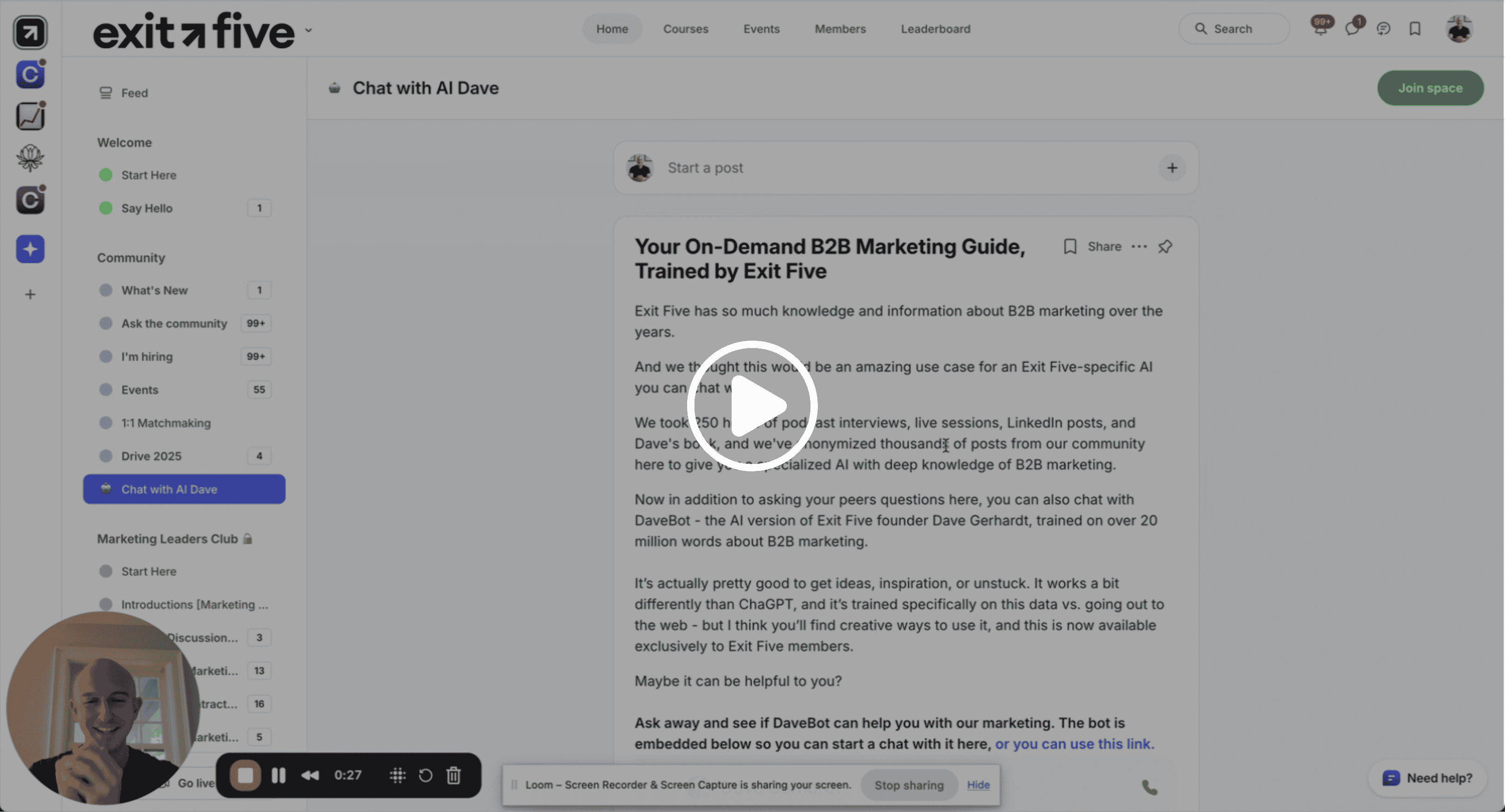
Stop wasting time with AI tools (for real) (Exit Five Newsletter)
.svg)



Hello and welcome to the Exit Five Weekly Newsletter — read by 42,000 B2B marketing professionals around the world. Exit Five is a membership site designed to help you build a successful career in B2B marketing. Join 5,700 other members at exitfive.com.
By the way — this email was designed in Knak, which helps you create email and landing pages in minutes without having to write code. Learn more about Knak here.
TOGETHER WITH WALNUT
📝 Did you know: 71% of small B2B teams use AI to create most of their content
.png)
And they’re not just using AI for fun, they’re using it to publish faster, smarter, and with less headcount.
In a new report from Walnut, 100+ B2B teams reveal how GenAI is moving from side project to core workflow, with small, scrappy teams leading the way.
In this report, you’ll learn:
- Top Use-Cases & Volume Trends
- What the 2025 AI Tool Stack actually looks like
- How to use AI with confidence and protect quality and brand voice
- Skill evolution and change management tips to get your team ahead
Don’t let AI pass you by, see how top teams are already putting it to work.
71% … Is that good? Or bad? Where do you fit?
✅ Real Example: An AI System That's Actually Working For A B2B Marketing Team

You launched five AI experiments last month, but how many are you still using?
If you're like most marketing teams, you’ve tried ChatGPT for blog outlines, tested some AI tools, maybe played with a few prompts for social content. Then two weeks later, it's like none of it happened. The experiments just fell off your radar.
Or if you’re like me - you open up LinkedIn, see someone posting about FIVE NEW WAYS TO USE CLAUDE. And you get instant FOMO, try something for a day, and it goes…nowhere. I am overwhelmed by how many new tools and updates and ways to use AI are out there.
But that’s because it’s easy for us to be treating AI like a series of one-off tests instead of building systems that actually compound over time (this is a weakness of mine, tbh).
But the teams seeing real results aren't launching more AI experiments. They're building repeatable systems around the ones that work.
We’ve heard that you want help separating the signal from the noise with AI stuff, so here today I’m going to share how.
Here's how Jennifer Cannizzaro (VP Product Marketing at Responsive) and her team moved from random AI experimentation to systematic AI implementation. And the exact tactics you can copy to do the same.
Hopefully this is a helpful read for you, reply back and LMK.
The Quality Test That Matters with Marketing
Jennifer's benchmark for whether AI is working? You can't tell it was used.
When she compared this year's thought leadership content to last year's, she couldn't detect any quality difference. But the first drafts took 75% less time to create.
Your quality checklist:
- Does this sound like your brand voice?
- Would a customer think a human wrote this?
- Does it include insights only your team would know?
If you answer no to any of these, your AI setup needs work.
What to Feed AI (The 4-Document System)
Most teams get stuck because they're not feeding AI the right inputs. But using these four core documents is a gamechanger:
- Core messaging and positioning - Your foundational strategy docs
- Voice and tone examples - Samples of your best past work by format type
- Target audience details - Specific, not generic audience descriptions
- Format guidelines - Different approaches for blog posts vs thought leadership vs social
The update rule: Every time you launch something new or iterate messaging, feed it back into your AI system. Treat it like training that never stops.
The Weekly AI Spotlight System
Run AI spotlights in every team meeting where one person shares what they're experimenting with.
How to run yours:
- Pick someone different each week
- Ask them to show, not just tell (screen sharing works)
- Focus on what worked AND what didn't
- Give everyone 5 minutes max
- Take notes on what others can try
Real examples:
- Someone built an agent to better understand a specific persona
- Another person compared outputs across different LLMs for the same task
- The team reverse-engineered what customers might be asking AI tools about their industry
The Annual Goals Framework
AI shouldn’t just be part of your weekly cadence, it needs to be incorporated into your larger goals, too. If someone on Jennifer's team doesn't include an AI-related goal in their annual planning, she sends it back.
3 types of AI goals that work:
- Capacity goals - "Use AI to increase content output by X% without additional resources"
- Learning goals - "Complete AI certification" or "Build three new AI workflows"
- Innovation goals - "Implement AI agent for competitor intelligence"
The rule: Every person needs at least one, but mix the types across your team.
The Team Challenge Method
Assign small groups specific AI problems to solve together, then they come back with recommendations.
How to structure yours:
- Groups of 2–3 people max
- Give them 2 weeks with a specific problem
- Examples: "Figure out AI for win/loss analysis" or "Build workflow for social content"
- Have them present findings to the whole team
- Implement the best ideas company-wide
The Documentation System
Constantly document what you try, what works, and what doesn't. This helps show business impact instead of just talking about AI potential.
Your tracking template:
- Tool/method tested
- Use case
- Time saved (if any)
- Quality rating (1–5)
- Would we use again? (Y/N)
- Next iteration ideas
Share this monthly with leadership before they ask what you're doing with AI.
The Platform-First Strategy
Jennifer focuses on AI within existing platforms before trying standalone AI tools.
Start here:
- What AI features exist in tools you already pay for?
- Can your CRM, content management, or analytics platforms do more?
- Test these before adding new tools to your stack
Then expand to general tools like ChatGPT for brainstorming and ideation.
What Not to Do
- Don't make AI goals generic - "Explore AI" isn't a goal. "Reduce blog production time by 50%" is.
- Don't skip the input work - AI without your strategic docs produces generic output.
- Don't wait for perfection - Start documenting experiments immediately, even failed ones.
- Don't treat it like magic - The more strategic context you have, the better AI performs.
Your 30-Day Plan
- Week 1: Audit your existing AI capabilities in current tools. Test what you already pay for.
- Week 2: Create your 4-document AI input system. Start with whatever docs you have.
- Week 3: Run your first AI spotlight meeting. Have someone share any AI experiment.
- Week 4: Assign your first team challenge. Pick one specific workflow to improve.
- Month 2: Add AI components to annual goal discussions. Document everything you try.
The bottom line? Jennifer's team didn't get better results by finding better AI tools. They got better results by being systematic about inputs, testing, and documentation.
Most marketing teams are messing around with AI all the time. But the teams pulling ahead are the ones treating AI as a system with repeatable processes, not a collection of random experiments.
- Dave
P.S. I’m super excited to share that we have a new Head of Marketing at Exit Five. Jess is going all in on AI for our business, using AI as much as possible to help us grow. Which means we’ll have a ton to share about what’s working. Can’t wait to share it with you.
But what’s really working for you right now? I want to know what you’re excited about doing with AI.
Do you want more real examples like this? How would you rate this newsletter 1–5? LMK
📺 UPCOMING EVENTS
Open to all
- October 7th: Beyond Copy: How To Use AI to Build GTM Systems That Scale (exitfive.com/live)
- October 16th: Exit Five New York City Community Meetup (exitfive.com/nyc)
Exit Five Pro Members Only
- TODAY: Local Meetup: Chicago, IL
- September 25th: Local Meetup: London, UK
- September 30th: The Best Industry Events for HR & HR Tech Marketers
- September 30th: Local Meetup: Boston, MA
- October 3rd: Non-SaaS Marketing Meetup: Content Strategies When Expertise Is the Product
Not a member yet? Learn more about an Exit Five Membership here.
If you are an Exit Five member, click here to RSVP to these events.
📚 LATEST CONTENT
Here's the latest from the Exit Five content library:
- 🎧 How to Use Cognitive Behavioral Branding to Create New Categories with Ari Yablok, Head of Brand at Island
- 🎧 From Employee #4 to CMO: The Path to Marketing Leadership with Sylvia Lepoidevin, CMO at Kandji
- 🎧 Research-First CRO: How Data Leads to Better Marketing Decisions with Haley Carpenter
- 🎧 The Future of GTM and Sustainable Growth with Chris Walker, CEO at Passetto
- 📰 How to Lead a High Functioning Marketing Org
- 📰 Marketing Is Broken: Why You’re So Busy and Still Not Getting Anything Done
- 📰 How to Put On a Virtual Event People Actually Want to Attend
🪪 NEW INSIDE THE EXIT FIVE COMMUNITY
New Inside Exit Five: DaveBot aka E5 AI

Check this out. We trained an AI model on 20 million words on B2B marketing, including 250 hours of podcast interviews, every LinkedIn posts I've ever written, every newsletter we've sent, and 40,000 comments from our community and we've built an incredible B2B Marketing Intern to help you out - now available exclusively to community members.
Join Exit Five and Try DaveBot Today
This newsletter was designed in Knak. Check them out here.

Want to sponsor a future newsletter or learn more about other sponsorship opportunities with Exit Five? Email hi@exitfive.com (or just reply to this email).

Sponsor the exitfive newsletter




